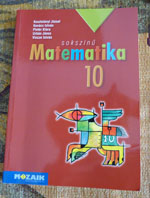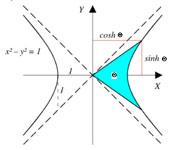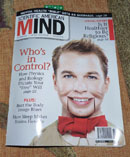Mathematics education

There were two motivations why I wrote this article:
- Recently I have undertaken coaching mathematics, physics and computer science.
- I saw an interesting video1 from the mistakes of mathematics education, and the lecturer outlined a better teaching method.
In this way I have recurrently getting a lot of experience about how bad methodology is used in mathematics education not only here in Hungary, but everywhere in the world.
But let us take some examples from my own experience:
...
Thoughts on „the language animal"
To George Steiner with love
The title is a bit misleading because I do not want to write about people but about an essay written George Steiner. I would like to answer to the problem of the cacophony of languages. George Steiner wrote about this problem a lot, for example in his essay titled "The talking animals", and it is also raised in his book titled "After Babel". The diversity of languages and thus the need of the process of translation are obstacles to human development, according to George Steiner. With these thoughts I want to argue, more precisely I would like to add a reassuring answer to what the writer says:
“... ... Any information theory, or a single model of awakening of human consciousness will not be convincing until they will not account for the deeply shocking antieconomical diversity of spoken languages on this crowded planet.”1
Steiner's approach is just the misunderstanding as it is in the ancient Babel story. Thousands of years ago people raised the tower to reach heaven according to the story of the Tower of Babel. God confused the languages of people to punish them for their pretension, so God inhibited people from reaching his residence in the sky. The image of avenging God can be found in this archaic tale, and it is well explained by the early struggle of humanity against the forces of nature.
__________________________________________________
1 This is not the original text of George Steiner from his essay titled “The language animal”. I translated it from Hungarian language.
After registration, you may ask for a translation of the full text by email.
Live speech vs. writing
Thoughts about a radio show
A few weeks ago, an interesting radio program was aired in the Space-time series: "From the stone tablet to the printer. Thoughts about writing". I also brooded on speech and writing and some claims of the program kindled my imagination.
The spoken and written word can be characterized in many ways:
- Because of its fixation, writing is dead but live speech is dead as well if it has already been spoken.
- Listening to spoken language and reading always means translating: the speech model of the author's thoughts have to be transformed into thoughts of the listener or thoughts of the reader.
- When reading a written text, there is no online real-time metacommunicational contact with the author, while this contact is strong in case of live speech.
- Both writing and live speech model contain more information by their nature what has been put into them.
Now I will review the details of the above.
After registration, you may ask for a translation of the full text by email.
There is no new thing under the sun
Why Plato did not become a politician
Without any comment, I quote from the 7th letter of Plato:
„In the days of my youth my experience was the same as that of many others. I thought that as soon as I should become my own master I would immediately enter into public life. But it so happened, I found, that the following changes occurred in the political situation. In the government then existing, reviled as it was by many, a revolution took place; and the revolution was headed by fifty-one leaders… Now of these some were actually connections and acquaintances of mine; and indeed they invited me at once to join their administration, thinking it would be congenial. The feelings I then experienced, owing to my youth, were in no way surprising: for I imagined that they would administer the State by leading it out of an unjust way of life into a just way, and consequently I gave my mind to them very diligently, to see what they would do. And indeed I saw how these men within a short time caused men to look back on the former government as a golden age …
But in no long time the power of the Thirty was overthrown together with the whole of the government which then existed. Then once again I was really, though less urgently, impelled with a desire to take part in public and political affairs. ...
When, therefore, I considered all this, and the type of men who were administering the affairs of State, with their laws too and their customs, the more I considered them and the more I advanced in years myself, the more difficult appeared to me the task of managing affairs of State rightly.
Moreover, both the written laws and the customs were being corrupted, and that with surprising rapidity. Consequently, although at first I was filled with an ardent desire to engage in public affairs, when I considered all this and saw how things were shifting about anyhow in all directions, I finally became dizzy; and although I continued to consider by what means some betterment could be brought about not only in these matters but also in the government as a whole, yet as regards political action I kept constantly waiting for an opportune moment; until, finally, looking at all the States which now exist, I perceived that one and all they are badly governed; for the state of their laws is such as to be almost incurable without some marvellous overhauling and good-luck to boot. So in my praise of the right philosophy I was compelled to declare1 that by it one is enabled to discern all forms of justice both political and individual.”
Information protection vs publicity
One of my friends drew my attention to an article on a web page on information protection.
The article deals with the Fifth Amendment to the United States Constitution1 and its use. I do not wish to discuss the given case now or outline encryption-related problems. I focus on a much more general problem instead; the fight of information security efforts and efforts in the disclosure of information. I worked in the field of informatics for nearly twenty years at big companies incl. multinational companies, initially as an IT auditor, and then as an IT security officer. Beside that, information theory became my favourite field of interest. The practice of the process of information and theoretical considerations shaped my opinion on the topics marked in the title.
______________________________
1"No person shall be held to answer for a capital, or otherwise infamous crime, unless on a presentment or indictment of a Grand Jury, except in cases arising in the land or naval forces, or in the Militia, when in actual service in time of War or public danger; nor shall any person be subject for the same offense to be twice put in jeopardy of life or limb; nor shall be compelled in any criminal case to be a witness against himself, nor be deprived of life, liberty, or property, without due process of law; nor shall private property be taken for public use, without just compensation.” (Wikipedia)
After registration, you may ask for a translation of the full text by email.
The problems of physics and the dilemma of CH in mathematics
I see a close relation between some of the basic questions of physics and the various definitions of continuum hypothesis.
First I mention the problem called quantum gravity. Serious difficulty is that some quantities become infinite in general relativity and quantum physics as well. An even greater challenge is creation of unified theory. I do not want to analyze the more successful and less fruitful attempts of unification. Instead, I'll relate these inefficient efforts with a mathematical question. Seemingly1 the most diverse properties of general relativity and quantum physics are their dealing with space and time, I think, and these attitudes are linked to the fact that one of them describes the enormous universe, and the other explains the micro-world.
In mathematics, there are two concepts - extensive and intensive infinity - which over large constructions have been establishing in mathematics, and they are seemingly independent from each other. Cantor’s transfinite numbers are not really harmonized with old-established and new methods2 of infinitesimal calculation.
________________________________________________________
1 I designate this as seeming difference because space and time appear as classic background in the quantum physics, but this view is misleading. Usage of complex probability amplitude implies non-classic space-time geometry in quantum physics. This, however, is not yet known because two-element numbers is not well known as models of space-time.
2 Abraham Robinson's non-standard analysis, with acceptance - but not widespread - has become extension of infinite quantities towards intensive infinity. This is the new concept of infinitesimals.
After registration, you may ask for a translation of the full text by email.
Time, Space and Infinity
 The space-time from a new perspective
The space-time from a new perspective
I have written a lot about the relation between the notions which are quoted in the title. I would like to summarize what we have known about them so far and what's totally new knowledge considering their attributes. Timeliness of this theme is yet that there was just one topic in a special edition of the Scientific American1 in the early this year. This topic was a matter of time. Hereinafter I write about a special characteristic of space-time and this attribute was not described in the mentioned magazine. In my former articles I have already written about these interesting attributes of space-time, but I did not describe the whole depth of the subject.
Content
1. Evolution of the concept of the time
2. Details from the rich literature of the concept of the time
3. The space-time notion in the 20th century
3.1 Einstein's algebraic description about the space-time
3.2 Geometric description of the space-time, use of hyperbolic functions
3.3 The usage of hyperbolic numbers for the description of the space-time
4. The contours of the new face of the mathematics in beginning of the 21st century
4.1 The hyperbolic numbers, as the one of the three basic systems of two-element numbers
4.2 The parabolic numbers, as the one of the three basic systems of two-element numbers
4.3 The two-element numbers and the geometry
4.4 Hidden presumptions of Cantor's diagonal method
4.5 The two-element numbers as the extensive and intensive models of infinity
4.5.1 The two-element numbers and the extensive infinity
4.5.2 The two-element numbers and the intensive infinity
4.6 Equivalents of continuum hypothesis
4.7 The duality of the extensive and intensive models of infinity
4.8 The concepts of the limit of functions and the continuity of functions
4.8.1 Definitions of metric on the plane of the two-element numbers
4.8.2 The generalized concept of metric
5. In the early 21st century as a result of fruitful ideas a new approach of space-time came into existence
5.1 The space as a projection of infinite time
5.2 Consequences of the new approach of time and space
___________________________________________
1 A Matter of TIME – It begins, it ends, it’s real, it’s an illusion. It’s the ultimate paradox. /Special collector’s edition of Scientific American, Volume 21 Number 1,
After registration, you may ask for a translation of the full text by email.
Reading Diary and Comments
 Scientific American Mind - May/June 2012
Scientific American Mind - May/June 2012
Three articles piqued my interest in the scientific magazine Scientific American Mind in the latest issue:
- Finding Free Will by Christof Kock
- Sleep’s Secret Repairs by Jason Castro
- Are We Born to Be Religious? by Vassilis Saroglou
My comments related to the articles are following.
1. On the free will - again
This theme is one of my favorites, as I wrote earlier. Some conclusions in the article are questionable, I do not agree with them. The described experiments are interesting, but they are explicable from quite another aspect as well.
The article lists some classic definitions of freedom and its examples, and then the author of the article writes about determinism, about chaos, about quantum-mechanical uncertainty principle. He draws a conclusion that “Both quantum mechanics and deterministic chaos lead to unpredictable outcomes.” This is almost similar to my opinion i.e. the problem is not the violation of the chain of the action-reaction, but the difficulty is the unpredictability of the future.
After registration, you may ask for a translation of the full text by email.
Trouble with double-slit experiment
Unfortunately, I have not been yet not only executing but I have never seen any experiment which has been carried out with a light or other particle radiation. So I am relying on solely my readings for imagining the light radiation which is an every-day experience for everybody. There is large literature on this subject, and I have read a lot - but not enough - on this subject.
Light - or, more generally, electromagnetic radiation, and what is more particles1 as well - can sometimes behave like particles and sometimes as a wave. Of course to the understanding of this assertion we need to know the meaning of the wave- and particle-behavior. The electromagnetic radiation is not accidentally a complex phenomenon, since it is able to supply all the information that we know about the distant universe, and about the microcosm. This vast amount of information could not be delivered via “simple media”.
Before dealing with the double-slit experiment, I would like to summarize my problems related to electromagnetic radiation. What does one photon mean?
________________________________________________________
1 The phenomenon is thought to be true for all objects, but it is only detected on atomic scale.
After registration, you may ask for a translation of the full text by email.
On the mathematics of the quantum theory II.
I wondered a lot how to go on proving the applicability of two-element numbers in the probability theory. In my article titled "The mathematics of quantum theory I" I said that in the probability of the macro-world, two-element numbers can be used, or more precisely parabolic numbers can be used as probability amplitudes. This feasibility is foreshadowed by the property of the parabolic numbers: In their sum and multiplication the moduli of the second component of the parabolic numbers do not affect the moduli of the first component of the sum or of the product, and that the sum of the squared moduli of the probability amplitudes, i. e. the classic probability is nothing else than the square of the moduli of the first element of the parabolic number, so it does not depend on the moduli of the second element of the parabolic number. It would be interesting to consider how the probability theory with parabolic numbers would benefit instead of counting with real numbers in it. On this basis, it would be logical if first I considered the probability methods, formulas with the use of parabolic numbers, and I checked whether I can find a contradiction somewhere or whether I come to a conclusion counting with the parabolic numbers that it is verifiable by experience but does not arise from the classical probability theory with real numbers. For now, I do not follow this path, but I will think over the probabilistic model of quantum physics because we already use two-element numbers in it, and decades of experience has proven the usefulness of this mathematical method. In the quantum theory, the notion of probability amplitude and the classical notion of probability are separated, so I hope that a general probability model can be constructed more easily based on these.
After registration, you may ask for a translation of the full text by email.



